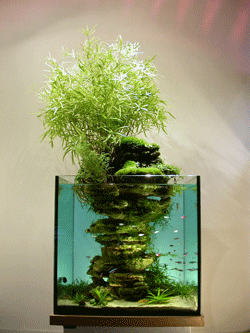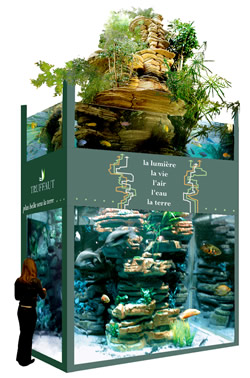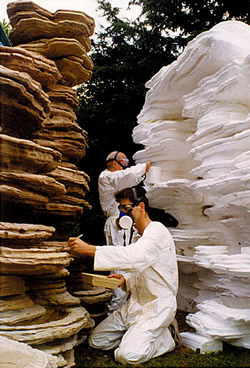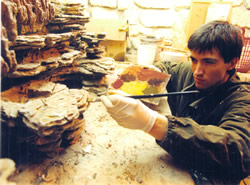| |
Concept
An ecosculpture is a miniature or life-size living landscape in which an ecosystem, a symbiosis of animal and plant life, develops.

Its volume varies from the size of a traditional aquarium to monumental productions several metres high. Ecosculptures are designed for indoor or outdoor settings and require very little aftercare.
These tailor-made sculptures, composed of varied natural elements : sculpted rock, ornamental pools, waterfalls, etc.., are enhanced with a set of aquatic and terrestrial flora and fauna able to live, grow and reproduce in a dynamic equilibrium over a number of years.
Ecosculptures are designs that recreate original mechanisms, and reveal themselves over time. The biotope is created so that the living things initially planted grow and reproduce themselves with the rhythm of the seasons.
 |
 |
| L’Ile Volcanique en 1998 |
L’Ile Volcanique 1 year later |
The conception
Each ecosculpture is an exercise in style; an illustration of a vision of nature imagined and recomposed using elements of reality.
A "recipient" in a New Light
A traditional aquarium includes a cover. The cover limits evaporation, but also masks the view from the above of the sub aquatic elements and the sparkle of the water's surface. To free the sculpture and allow these living factors room to express themselves, Paul Louis Duranton removed the cover. His design goes beyon the the limits of the glass recipient to qualify the terrestrial space.
To remedy the problem of the natural evaporation of water in a heated indoor setting, he perfected a water reserve system hidden in the base. Everything is integrated, there are no maintenance constraints or loud or cumbersome pumps. All we see is the beauty of the piece.
An ecosculpture, much more than a traditional aquarium…
 |
In addition to the obvious aesthetic differences, since "traditional" aquariums only rarely include decoration that emerges from the water, ecosculptures differ in their degree of autonomy..
The rock formations that emerges out of the water are the stage for a veritable plant explosion. This is dure to constant irrigation and the presence of "natural" fertilisers produced by the fish. Water pollution is therefore controlled naturally and the aquatic living environment is renewed.
|
"Piton Paradis", maître d’ouvrage Truffaut
Stade de France, 2001 |
|
The ecosculptor must present objets that delights the senses while are able to sustain life. Shivers of subtle colours, reflections of waves and fish shadows across the surrounding walls and the songs of waterfalls balance and echo one another...
Alchimy and sculpture
Technique ans know-how
 |
The main part of the work consists of bringing this rocky shape to life by steeping it in an entire "geological past". The mineral world, a building block of the biotope, offers us an infinite variety of shapes, colours and materials. This is a world in development where the strata, the folds, the breaks, shapes that are smooth or complex, recent or worn, paced or disorganised, remind us of the history of their morphogenesis. Some are the work of time, erosion caused by water and wind, some are the work of natural disasters such as earthquakes, volcanic eruptions, rock falls, breaks , landslides, etc.
The shapes are modelled by hand. His tools, like his sculptures, are unique and cannot be reproduced.
|
|
Two monumentals sculptures monumentales at different stages (sculpture, pollishing)
|
|
The composition of volumes that appears to be instinctive hides a complex design linked to the installation and integration constraints for the technical elements such as pumps, filters and gravity irrigation.
unique pieces during the colouring work
 |
Production is followed by patient colouring work using pigments and patinas. The range of colours of the rocks is incredibly varied. He uses ochres, earthy tones, clay, pink (sandstone)... A thousand nuances spring to life at the touch of his brush.
The result comes from his inspiration and the presence he wishes to confer upon his design. It is both an ornamental pool and a living sculpture - an art aquarium.
|
|
Chromatic work in workshop.
|
Some technical informations
Indoor or Outdoor?
Each creation is a unique piece; it will be designed to operate in a planned environment, whether indoor or outdoor.
- In an outdoor setting, the presence of natural light provides ideal plant growth, but the orientation (north or south facing) determines the style of vegetation and atmosphere. The strong climatic variations limit the possibilities for the fauna and flora. The composite rock sculpture is reinforced. The water is slightly heated to avoid ice forming in winter. A stronger mechanical filtration system is used.
- In an indoor setting, if an additional artificial lighting is provided, the relative stability of the ambient temperature results in an ideal situation for growing a tropical ecosystem, and thus having a stable vegetation throughout the year which is not the case for all regional outdoor plants. Water is heated to compensate for temperature variations due to draughts.
The rock sculpture:
It is a slightly miniaturized landscape or a full size one. It can be an imaginary landscape, or a accurate reconstruction of a geological site.
The sculpture is made using composite materials (based on the techniques used in aeronautics). It is resined, sanded down, polished, pigmented and patina is applied.
These rock shapes are always very light, chemically neutral and rot-resistant. Depending on where they are to be placed, they can be tailor made to withstand specific conditions: high mechanical resistance, indoor or outdoor, difficult climates, flame retardant, etc.
The lightweight nature of the sculpture allows great freedom for creativity and design. This lightness is also an excellent argument for this kind of sculpture instead of a traditional, very heavy aquarium, when the floor cannot support a great weight (indoor situation far from a supporting wall, veranda, balcony, terrace etc.)
The base or technical section:
it hides the water reservoir, the pump, electric cables and electric transformers for low voltage lighting. For installations with no base (directly on the ground), the technical part can be placed inside the sculpture behind a rock, or outside it, in the ground, behind a partition, etc.
Light :
It activates the photosynthesis. It is therefore crucial!
If there is plenty of natural light (light well or bay window for example), artificial lighting is used for an aesthetic effect only. However, for spaces where there is little natural light, artificial light is needed for approximately 12 hours per day for the plants to survive.
The lighting system can either be integrated in the sculpture or independent (spot lighting).
Water :
The system is open, so there is significant water evaporation. It contributes to improving the air humidity in the space in which the ecosculpture is placed. Topping up can either be done manually (tap water or demineralised water) or automatically. If the system is automatic, there must be a tap and wastewater outlet close by.
Living things :
Plants and fish are chosen according to the climate of the place where the sculpture is to be installed. Integrated heating maintains the water at the right temperature.
Tanks :
Small or medium-sized tanks (water level < 1m), these are made from glass stuck to clear or black silicone. For water pressure of greater than 1m, the glass slabs are fitted into soldered and resined metallic angles. For water levels higher than 2m40, or circular (columns), oval, or rounded shapes, the tanks are generally made from methacrylate.
Maintenance :
There is very little, since the ecosculpture functions as an ecosystem and as such is based on self-sufficiency and recycling. The plants are automatically watered and fed. The écosculpture will therefore enhance itself as the years go by.
Maintenance is reduced to feeding the fish once or twice a week.
Once a year, plan to trim the vegetation if necessary, change the filter mass, clean the glass and change a third of the water.
We can carry out these tasks as part of a maintenance contract
©2012 - Atelier Paul Louis Duranton - All rights reserved - Partners - Référencement naturel
|

